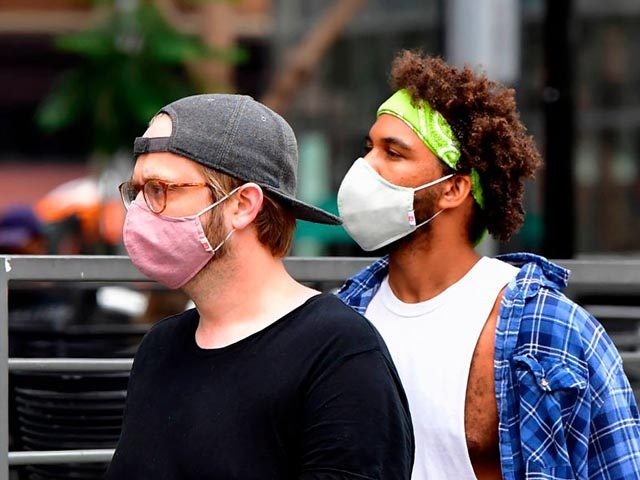An overlooked study published recently by the U.S. Centers for Disease Control and Prevention (CDC) suggests that cloth face coverings or masks are mostly ineffective in preventing the spread of the Chinese coronavirus as promoted by public health officials.
The CDC conducted the study, largely ignored by the media, in the U.S. in July and made its findings public in September. It compared 154 “case-patients,” those who tested positive for COVID-19 (coronavirus disease), and a control group of 160 “control-participants,” those who were symptomatic but tested negative.
CDC researchers examined participants who reported wearing a cloth face covering or mask at least 14 days before illness onset, which falls into the incubation period of 2–14 days estimated by the agency.
The researchers found that 71 percent of the case-patients contracted the virus despite reporting “always” wearing a cloth face covering or mask at least 14 days before illness onset, and 14 percent contracted the virus despite reporting “often” wearing one at least 14 days before illness onset.
That indicates 85 percent of the COVID-19 study participants contracted the virus even after either always (71 percent) or often (14 percent) wearing a face covering or mask, suggesting the masks are not entirely effective at preventing the spread of the coronavirus.
Additionally, the rate of COVID-19 patients who wore a mask mirrored the percentage of those who were showing symptoms but tested negative, suggesting that the masks did little to protect those who did not test positive from symptoms.
“In the 14 days before illness onset, 71% of case-patients and 74% of control-participants reported always using cloth face coverings or other mask types when in public,” the CDC reported.
Of the other positive patients who reported wearing a face covering or mask, seven percent did so “sometimes,” four percent “rarely,” and four percent “never.”
Acknowledging the limitations of the study, the CDC pointed out, “Adults in the study were from one of 11 participating health care facilities and might not be representative of the United States population.”
Notwithstanding the efforts of the 71 percent of patients who reported “always” wearing a mask, they still caught the highly contagious coronavirus.
Wearing a mask at “gatherings with ≤10 or >10 persons in a home; shopping; dining at a restaurant; going to an office setting, salon, gym, bar/coffee shop, or church/religious gathering; or using public transportation,” did not prevent them from getting infected, the CDC study indicated.
Nevertheless, Dr. Anthony Fauci and CDC Director Dr. Robert Redfield, both prominent members of the White House Coronavirus Task Force, and other public health officials have urged everyone to wear masks.
Redfield went as far as telling a Senate panel last month that masks are “more guaranteed” to protect against the coronavirus than a potential vaccine.
California Gov. Gavin Newsom’s (D) mandated use of masks in his state prompted the governor’s office to urge restaurant patrons via Twitter in October to keep their masks on while dining.
“Going out to eat with members of your household this weekend? Don’t forget to keep your mask on in between bites. Do your part to keep those around you healthy,” he tweeted.
Going out to eat with members of your household this weekend? Don't forget to keep your mask on in between bites.
Do your part to keep those around you healthy. #SlowtheSpreadhttps://t.co/snYe5v55Rw pic.twitter.com/Y4fcDO5Zke
— Office of the Governor of California (@CAgovernor) October 3, 2020
Despite the CDC’s latest findings that masks may be ineffective against the virus, they are now required across most of the state of California and other regions, where leaders urge individuals to wear a mask when keeping at least six feet apart is impossible.
Yes, you still have to physically distance on Halloween.
Read @CAPublicHealth's #COVID19 Halloween guidance to learn how you can ward off unwanted germs and still have a spooktacular time: https://t.co/snYe5v55Rw. 🎃#YourActionsSaveLives pic.twitter.com/0CSxhWdqly
— Office of the Governor of California (@CAgovernor) October 13, 2020
The CDC study found that positive participants were more likely to go out for food than those who tested negative, acknowledging that wearing a face covering while eating and drinking is virtually impossible.
“Adults with confirmed COVID-19 (case-patients) were approximately twice as likely as were control-participants to have reported dining at a restaurant in the 14 days before becoming ill,” CDC noted. However, the health agency conceded that there is no accurate way to pinpoint whether the COVID-19-infected participants contracted the disease when they took their masks off to eat or drink.
“Characterization of community exposures can be difficult to assess when [the] widespread transmission is occurring, especially from asymptomatic persons within inherently interconnected communities,” the CDC pointed out.
The agency further suggested that “direction, ventilation, and intensity of airflow might affect virus transmission, even if social distancing measures and mask use are implemented according to current guidance.”
“Most close contact exposures were to family members, consistent with household transmission of [COVID-19],” the CDC added.
The CDC investigation was carried out on adults over 18 years old who received the test for the virus at an outpatient testing or healthcare center at one of 11 health centers throughout most of July (1–29).
That same month, Fauci, the National Institute of Allergy and Infectious Diseases director, came out against conducting a controlled study on the effectiveness of masks to prevent the spread of the Chinese virus.

COMMENTS
Please let us know if you're having issues with commenting.